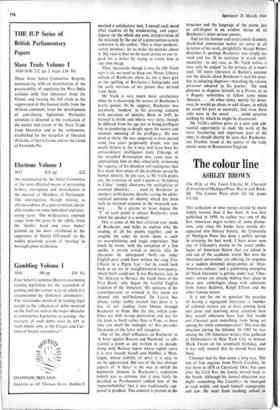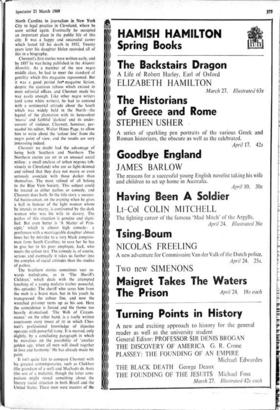The colour line
ASHLEY BROWN
The Wife of His Youth Charles W. Chesnutt (University of Michigan Press; Barrie and Rock- liff : The Cresset Press cloth 32s 6d, paper 17s 6d)
This collection of nine stories should be more widely known than it has been. It was first - published in 1899, its author was one of the first American negro writers of some distinc- tion, and, since his books have mostly dis- appeared into literary history, the University of Michigan Press has done a public service in reissuing his best work. I have never seen any of Chesnutt's stories in the usual antho- logies of American fiction that are edited in and out of the academic world. But now the American universities are offering (in response to a sudden demand) programmes in 'Afro- American culture,' and a publishing enterprise of 'black literature' is getting under way. Ches- nutt's stories are already finding their place in these new anthologies along with selections from James Baldwin, Ralph Ellison and the other famous names.
It is not for me to question the practice of having a segregated literature—a number of talented writers are at least coming back into print and receiving more attention than they would otherwise have had—but would not Chesnutt gain something from being set ainong his white contemporaries? This was the situation during his lifetime. In 1905 he was among the 150 American writers who gathered at Delmonico's in New York City to honour Mark Twain on his seventieth birthday, and it was only natural that he should have been there.
Chesnutt had by then come a long way. The son of free negroes from North Carolina, he was born in 1858 in Cleveland, Ohio, but soon after the Civil War the family moved back to the South. Although his formal education was slight—something like Lincoln's—he managed to read widely and teach himself stenography and law. He went from teaching school in
North Carolina to journalism in New York City to legal practice in Cleveland, where he
soon settled again. Eventually he occupied an important place in the public life of this city. It was a happy and successful career which lasted till his death in 1932. Twenty years later his daughter Helen recorded all of this in a biography.
Chesnutt's first stories were written early, and by 1887 he was being published in the Atlantic Monthly. As a member of the new negro middle class, he had to meet the standard of gentility which this magazine represented. But
it was a good period for• magazine fiction, despite the cautious taboos which existed in most editorial offices, and Chesnutt made his way easily enough. Like other negro writers (and some white writers), he had to contend with a sentimental attitude about the South which was widely held in the North—the legend of the plantation with its benevolent `massa' and faithful `darkies' and its under- current of violence. Chesnutt, however, per- suaded his editor, Walter Hines Page, to allow him to write about the 'colour line' from the negro point of view, and the results are very interesting indeed.
Chesnutt no doubt had the advantage of being both Southern and Northern. The Northern stories are set in an unusual social milieu: a small enclave of urban negroes (ob- viously in Cleveland) who are so light-skinned and refined that they dare not marry or even seriously associate with those darker than themselves. The most refined of all belong
to the Blue Vein, Society. This subject could
be treated as either pathos or comedy, and Chesnutt does both. In the title story a success- ful businessman, on the evening when he gives a ball in honour of the light woman whom he intends to marry, is confronted by the dark woman who was his wife in slavery. The pathos of this situation is genuine and digni- fied. But even better is `A Matter of Prin- ciple,' which is almost high comedy: a gentleman with a marriageable daughter almost loses her by mistake to a very black congress- man from South Carolina; to save her he has
to give her to his poor employee, Jack, who meets the colour test. The comedy is, of course,
serious and eventually it takes us further into the complex of racial attitudes than the studies of pathos.
The Southern stories sometimes veer to- wards melodrama, as in 'The Sheriff's Children,' which deals with the attempted lynching of a young mulatto (rather powerful, this episode). The sheriff who saves him from
the mob is a brave man, but in his youth he transgressed the colour line, and now the wretched prisoner turns up as his son. Here the coincidence is forced and the theme too heavily dramatised. 'The Web of Circum- stance,' on the other hand, is a tautly written courtroom story (most of it) in which Ches- nutt's professional knowledge of injustice operates with powerful irony. It is marred, only slightly, by a concluding paragraph in which he moralises on the possibility of 'another golden age, when all men will dwell together in love and harmony.' He has already made his point.
It isn't quite fair to compare Chesnutt with his greatest contemporaries, such as Chekhov (the grandson of a serf) and Machado de Assis (the son of a mulatto), though the latter com- parison might reveal something about the literary racial situation in both Brazil and the United States. These men were masters of the short story in countries which were spared the worst sentimentalities of Anglo-American fic- tion, and they were, of course, professional writers. Where Chesn.utt shows to advantage is beside 0; Henry and Bret Harte; he is de- cidedly better—and more honest—than either of them.












































 Previous page
Previous page